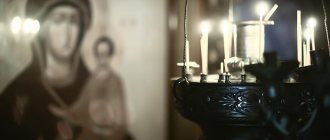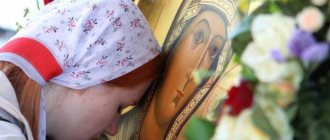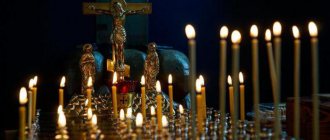Sretensky candles are one of the church attributes that helps to direct your prayer to God. In the case of using Sretensky candles, this prayer must be special, have a strong appeal that differs from the daily one. Sretensky candles help believers in many ways; such a candle can be lit at home, which means every person with good thoughts can turn to God with it. Today we will talk about when the Sretensky candles are lit, about the meaning of the Sretensky candles. Read the following article on the pages of the magazine.
Sretensky candles
The Sretenskaya candle combines the symbolism of two historical and cultural traditions. The light of a ritual candle cleared the path for a person, neutralized obstacles, and was that guiding star that indicated not only the paths of today, but throughout the entire path of life.
Usually people prepared Sretensky candles in advance. Those who kept bees melted the largest candles; those who did not have them bought yellow wax in a store or from familiar beekeepers. Typical dimensions were as follows: the length should be approximately ten inches (44 cm), and the thickness should be three-quarters of an inch (about 3.5 cm).
The Sretenskaya candle combines the symbolism of two historical and cultural traditions
Such sizes were determined by the practice of economic activity and the number of ritual situations in which the Sretensky candle acted as a key attribute: the candle was placed in the hands of a seriously ill person; the son-groom and daughter-bride were blessed with a candle; it was lit during the birth of a child, etc. Today, only beekeepers are able to make a real Candlemas candle. Most often, candles are bought in churches.
Sretensky candles meaning
The Orthodox Church needs to treat Sretensky candles in a special way - not magically, but reverently. At the same time, the Church strictly warns against a superstitious attitude towards candles.
You cannot attach any magical or miraculous meaning to them, because a candle is only a symbol of our prayer. The Sretenskaya candle, like any church candle, is intended solely for lighting it during prayer.
Usually Sretensky candles are lit only on special occasions: when we pray when solving important life problems (choosing a life partner, choosing a profession, getting a job, purchasing a house, car, etc.), when we are overcome by illness, grief, sadness, or when the obvious effect of demonic forces on humans.
Meaning and features
The tradition of celebrating the Presentation in Orthodoxy appeared in the 17th century. Consecrated objects were given special significance on this day. Believers kept them in chests among valuable things. They lit it only on special occasions.
The composition also received symbolic meaning. Oil represents God's mercy. Beeswax means the pleasure of communicating with the Almighty. The temple is not the only place where you can buy church candles. Blessed goods are sold in online stores.
Sretensky differ from others in the following:
- Used for special moments. With their help, they ask the Lord to cure serious illnesses, pray for forgiveness, and ask for a fateful sign. The prayer of the Sretensky candle is stronger than the usual one.
- They are consecrated with a great ceremony once a year on a holiday. An ordinary one can be consecrated with a small rite at any time of the year.
The value of using the Sretensky candle at home is stronger than usual. You should not endow it with magical properties. The true faith of the Orthodox brings his petition to the Lord.
When the Sretensky candles are lit
The Feast of the Presentation, which is celebrated in Russia today, is known as one of the central Christian holidays of the year. The symbol of the holiday is a lit candle. The ritual of blessing the candles for Candlemas takes place in the church immediately after the liturgy.
A special prayer is read over the candles, then they are sprinkled. This is done in order to light a special candle at home during personal prayer, so that it will help the believer become closer to God. Such candles are credited with magical properties.
Sretensky candles were lit when a thunderstorm was raging outside in order to protect the home from lightning. This tradition is associated with the ancient beliefs of Ukrainians, who attributed lightning to the wrath of Perun (and later Elijah the Prophet). The candle was supposed to “ward off trouble.”
The Sretenskaya candle, like any church candle, is intended exclusively for lighting during prayer. The main difference from the ordinary church is the rite of consecration. Any prayer to the Lord Jesus Christ, to the Mother of God, or to the saints during the lighting and burning of the Sretenskaya candle, has a special grace-filled power, and if accompanied by the sincere faith of the person praying, it leads to the speedy fulfillment of what was asked.
LiveInternetLiveInternet
Monday, March 02, 2015 13:59 + in the quotation book “Sretensky” candles and the rite of their consecration
“Sretensky” in everyday life refers to candles blessed according to a special rite on the feast of the Presentation of the Lord (February 2/15). The exact name of the rite in question is “The rite of blessing the candles at the Presentation of the Lord” [1]. Let us note, firstly, that it should not be confused with the usual blessing of candles, which is not dedicated to any specific date, and, secondly, that the liturgical charter of the Orthodox Church does not prescribe the rite of blessing candles for the Presentation.
Candlemas. Manuel Panselin. Painting of the Cathedral of Protatos in Kareia, Athos. XIII century
As priest Mikhail Zheltov points out, the rite of blessing candles for the Feast of the Presentation is absent in the Greek Church; He is also unknown to the Old Believers. It was first introduced into the practice of the Orthodox Church after in 1646, Metropolitan of Kiev St. Peter (Mogila) published the Euchologion, Albo Prayer Book, or Trebnik, compiled by him. This Trebnik contained 37 rites, which had never before been found in the liturgical books of the Orthodox Church. Some of them (rites for the consecration of liturgical vestments, bells, etc.) are revised translations of rites from the Latin “Roman Ritual” (Rituale Romanum). Among the Latin borrowings in the Breviary of St. Peter (Mogila) is the rite of blessing candles for the feast of the Presentation [2]. “Catholics had such a ritual - a procession with candles on Candlemas. For this ritual, candles are consecrated, or rather, blessed. Catholics distinguish between “consecrations” (the substances of the sacraments are subject to consecration, as well as objects directly for liturgical practice) and “blessings” (objects of everyday life are subject to blessing: apartments, cars, etc. - just like objects for all other similar rites (e.g. ashes for Ash Wednesday))” [3].
In the divine service of the Catholic Church, the rite of blessing candles for the Presentation is an integral part of the procession with candles dedicated to this holiday. However, in Orthodox worship there is nothing similar to the Catholic Candlemas procession. Because of this, the very rite of blessing candles for this holiday loses its meaning. Indeed, why bless candles specifically for Candlemas, if in the Orthodox liturgical tradition this holiday does not involve any special use of candles?
It should be noted that in the divine services of the Catholic Church, the procession with candles to Candlemas did not immediately become a stable tradition.
The existence in the Roman Church of the feast of the Presentation itself (called the Purification of the Virgin Mary) is reliably recorded only from the 7th century. Procession in Rome on the day of the Presentation, introduced by Pope Sergius I (687-701), until the 12th century. had a penitential, not a festive character. The very tradition of celebrating Candlemas spread slowly in the West. The custom of blessing candles probably originated in the Frankish kingdom and did not become widespread until the 11th century. In the 12th century In Rome, the custom was established to sing the song of Simeon the God-Receiver “Nunc dimittis” (“Now you let go”) during the blessing of candles. Throughout the Middle Ages, in different regions of Western Europe, the festive procession had its own characteristics. Only in 1570 did the Roman Missal establish the following order: candles blessed by the priest are distributed to the clergy and laity, while the choir sings the song of Simeon the God-Receiver; after each verse the antiphon “Lumen ad revelationem gentium et gloriam plebis tuæ Israel” (“light for the revelation of tongues and the glory of Your people Israel”) is sung. Then a solemn procession begins, the participants of which carry lighted candles. It is believed that the procession symbolizes the entry of Christ - the Light of the world - into the Jerusalem Temple [4]. The procession with candles, having become a distinctive feature of Candlemas, gave the name to the holiday itself in European languages (German Lichtmess, Spanish Candelaria, French Chandeleur, English Candlemas from Candle Mass).
And yet, a lot of time passed before the candlelight procession began to be perceived as an integral part of the service of the Feast of the Presentation in the Catholic Church. In the Orthodox Church, such a tradition has not been formed at all [5].
This, apparently, indicates that there is nothing in the meaning and significance of the Candlemas holiday itself that would necessitate placing special emphasis on the use of candles in the worship of this day.
The fact that over time the solemn procession with candles became a characteristic feature of the celebration of the Presentation in Catholic countries could be due to the Church’s opposition to pagan superstitions.
The period from early to mid-February, when winter begins to gradually give way to spring, could not but have an important meaning in people's lives, and from time immemorial many rituals and signs have been associated with it. On these days, the pagan Celts celebrated Imbolc, the Romans - Lupercalia, the Slavs - Gromnitsa (after the adoption of Christianity among a number of Slavic peoples, the Candlemas holiday began to be called that) ... These pagan festivals were accompanied by cleansing rituals, lighting fires and performing other magical actions that were supposed to promote fertility of people and animals, their protection from hostile forces.
It can be assumed that the desire of the Church to distract the people from the usual pagan rituals, in particular, from the widespread superstitious veneration of fire, became the reason for the gradual spread of the solemn procession with candles dedicated to Candlemas.
However, echoes of pagan fire worship persisted among the people for a long time. A number of beliefs associated with the sacred fire before the adoption of Christianity were then transferred in the popular consciousness to candles blessed on the feast of the Presentation. These beliefs formed a stable complex spread throughout Europe. The most famous belief is that if you light a candle consecrated for Candlemas during a thunderstorm, you can protect your house from lightning. Such a candle was credited with the ability to ward off demons. It was also believed that the candle consecrated for Candlemas should be lit under particularly difficult life circumstances, for example, when one of the family members was sick or near death. Such beliefs are still common among Catholics - from Spain to Ukraine.
In Poland, the holiday of the Presentation was called the holiday of the Mother of God of Gromnica: an echo of pagan Slavic myths about the holiday of Gromnitsa, associated with the veneration of the thunder god and his wife. Here, after the festive service, they tried to bring the candle home burning if possible. They walked around the house with her, and inside, candles burned out crosses on the ceiling. This was done to protect against evil spirits and fire [6]. The candles themselves, consecrated at Candlemas, began to be called gromnitsa or gromnichnye among the Poles, Ukrainians, and Belarusians.
“The Jesuit Lencki, in his Catechism, published by the Vilna Academy in 1768, says, “that these candles destroy the power of demons, so that they do not harm with thunder and lightning, torrential rains and hail, which are easily brought down, by God’s permission, by sorcerers or sorceresses; and therefore the faithful light these candles during a thunderstorm in order to experience the fruits of prayer; They also give a thunderbolt into the hands of the dying to defeat and drive away Satan, the prince of darkness,” etc.” [7]. A Russian scientist a hundred years later, in the middle of the 19th century, testified: “In the Vilna province, the Most Holy Mary Gromnitsa is celebrated on February 2, and during the service they stand in the church with lighted candles, which are called thunderclaps and are kept for a whole year to protect the house from thunder strikes, lighting them during a thunderstorm in front of the images” [8].
The custom of blessing candles on the feast of the Presentation, borrowed from Catholics, has become widespread in Orthodox parishes in the western (and bordering) provinces of the Russian Empire. Researchers of the 19th century recorded the beliefs of Orthodox Ukrainians and Belarusians associated with thunder candles. They, like other European peoples, attributed the magical ability to ward off demons and witches, thunder and lightning, rain and hail. Therefore, during a thunderstorm, in order to avoid a lightning strike, they tried to light a thunderclap. In Ukraine, it was also lit in case of fire in the village. The Sretensky candle was also given to the dying person to make it easier for him to “depart” and to ward off evil spirits. In addition, Russians in the north-western regions and Belarusians returned from church with a lighted thunderclap and used it to tell fortunes, and also performed the ritual of placing bread and candles around the table. The smoke from the Sretensky candle was used to draw crosses on the ceiling beams. On the feast of the Presentation, peasants of the Western Russian region set fire to each other's hair in a cross shape with Sretensky candles, believing that this would help with headaches. [9]
The belief that a lit candle could protect against lightning and fire was apparently based on the superstition that “fire will not meet fire.” For example, in Russia in the 19th century. in some areas, during a thunderstorm, a fire was specially lit in the stove (although usually in Russian villages during a thunderstorm they tightly closed the windows and closed the pipes). They often kept firebrands in the house against fires caused by lightning. During a fire, they lit the stove in the house next to the one that was burning, believing that fire against fire would put out the fire [10]. In the Carpathians, peasants believed that when a hail cloud approaches, they need to light an Easter candle and put it in the oven so that the smoke from it rises to the sky through the chimney [11]. (Similar beliefs existed in different places in Europe. Thus, in England and Brittany, a charred branch from a fire that burned on the summer solstice was considered a means of protection against lightning; in Westphalia, when a thunderstorm approached, a Yuletide log was placed on the fire [12].)
In most of the Great Russian provinces before the revolution there was no blessing of candles on the feast of the Presentation. The properties of a magical amulet, which in the West were attributed to the “Sretensky” candle, were endowed here with the “Thursday” candle [13] (with which they stood in the church at the service during the reading of the 12 Gospels in the evening on Maundy Thursday) and the “Easter” [14] ( they walked around the church with her during the procession on Easter).
As we can see, attributing the meaning of a magical amulet to church candles was widespread. But, of course, such a superstitious attitude towards candles has no basis in the teaching of the Church itself. According to the Orthodox tradition, “a candle burning in front of an icon is a sign of our faith and hope for God’s gracious help, always abundantly sent to everyone who flows with faith and prayer to the Lord and His saints. A lit candle is a symbol of our flaming and grateful love for God” [15]. As Saint Philaret (Drozdov), Metropolitan of Moscow, wrote, “the light of a candle should signify reverence for the holy icon and make it convenient to see it” [16]. It also follows from this that there are no “more grace-filled” or “less grace-filled” candles, and, for example, an “Easter” candle does not have greater “holiness” than an “ordinary” candle blessed in church.
The holy righteous John of Kronstadt advised: “Seeing burning candles and lamps in the church, ascend in thought from the material fire to the immaterial fire of the Holy Spirit: our God is a consuming fire (Heb. 12:29) ... A candle or lamp reminds us of spiritual light and fire, for example, about the words of the Lord: I am the light that has come into the world, so that everyone who believes in Me will not remain in darkness (John 12:46), or: I have come to cast fire on the earth, and whatever I want is already on fire (Luke 12 , 49), or: let your loins be girded, and your lamps burning, and you be like a man who waits for his Lord when he returns from marriage, so that when he comes and pushes, the door will be opened to him (Luke 12:35, 36), or: so let your light shine before men, for they may see your good deeds and glorify your Father who is in heaven (Matthew 5:16) - and by their very prophetic nature, by their very being, teach us spiritual things or objects corresponding to light and fire, for example, so that our hearts always burn with love for God and neighbor, so that we do not allow passions or the fire of hell to flare up in ourselves, so that we shine as an example of a virtuous life for others, as a candle shines for us in everyday affairs...
It is good to place candles in front of icons. But it is better if you sacrifice to God the fire of love for Him and your neighbor. It’s good if both happen together. If you light candles, but do not have love for God and your neighbor in your heart: you are stingy, do not live peacefully, then your sacrifice to God is in vain...
Your candle is like a burnt offering to the Lord; may it be a gift to God from a perfect heart” [17].
* * *
Thus, the rite of blessing candles for the feast of the Presentation was adopted in the 17th century from the Catholic tradition. The attribution of “special” properties to the “Sretensky” (or any other) candles is rooted not in Christian doctrine, but in the pagan worldview, when a person wants, after performing a certain ritual, to acquire a talisman that protects from everyday troubles and sorrows, and at the same time not to make any efforts to improve your life.
“The Church consecrates Candlemas candles as a sign of sanctification and cleansing of the world with the true Light of Christ’s Gospel.” This is a symbol, a certain tradition.
Here is another excerpt from one article: “In the Orthodox breviary of a clergyman there is a special “Rite of blessing candles for the Presentation of the Lord.” Someone may ask: what is the difference between an ordinary church candle and a “Sretenskaya” candle? Only by the rite of consecration, because simple church candles that are sold in shops are also consecrated. For a better understanding, we can draw an analogy with the blessing of water. So, for example, when water-blessing prayers are served in a church: the water is blessed in a small rite, one might say “ordinary.” But there is also such a thing as the consecration of water with a great rite, and this is done only once a year - on the feast of the Epiphany, and this water is called the Great Agiasma, i.e. “great shrine”, and has special power.
It’s the same with the “Sretensky candles” - they are consecrated only once a year with a special rite. However, this does not mean that the “Sretensky candles” should be given some kind of magical or miraculous meaning - these are extremes, of course. After all, any candle, if you pray fervently, warms the prayer. The candle is our sacrifice to God.”
About the “miraculous” Sretensky candles and Sretensky water.
Sretensky superstitions.
In the Orthodox breviary of a clergyman there is a special “Rite of blessing candles for the Presentation of the Lord.” Someone may ask: what is the difference between an ordinary church candle and a “Sretenskaya” candle? Only by the rite of consecration, because simple church candles that are sold in shops are also consecrated.
For a better understanding, we can draw an analogy with the blessing of water. So, for example, when water-blessing prayers are served in a church: the water is blessed in a small rite, one might say “ordinary.” But there is also such a thing as the consecration of water with a great rite, and this is done only once a year - on the feast of the Epiphany.
It’s the same with the “Sretensky candles” - they are consecrated only once a year with a special rite. However, this does not mean that “Sretensky candles” should be given some kind of magical or miraculous meaning - these are extremes, of course.” Orthodox Christians light “Sretensky candles” during home prayer, like other church candles. After all, any candle, if you pray fervently, warms the prayer.
A church candle is, first of all, your sacrifice to God. A sacrifice is what a person gives away from his material condition without receiving in return the material equivalent of what was given. For example: if in a store you give the seller a certain amount of money and receive in return some product worth that amount, this is not a sacrifice. In fact, you did not give anything away, but only exchanged one form of property (money) for another (goods). If you buy a candle and burn it at home, using its light for reading or just for illumination, this is not a sacrifice.
If you bought a candle in a church and set it to burn in front of some icon or shrine, this is a sacrifice. If you gave alms to a beggar, or put money into a “church cup” for the restoration of a temple, this is a sacrifice.
Sacrifice is a gift, an expression of our love for the one to whom we bring this gift. And only then is our sacrifice pleasing to God when it is offered from a pure heart. It doesn't matter what the material cost of this sacrifice is.
When a child gives his father a hand-made drawing or craft for his birthday, it is no less pleasing to the father than if the child gives him an expensive tie or shaving cream bought with money given by his mother.
Some try to enter into a “commercial relationship” with God, for example: “Lord! Do this and that for me, and I will light you the thickest candle in church!”
God does not need thick or thin candles. God needs loving hearts. We need candles as an opportunity to express our love for God, as a symbol of our fervent prayer, rushing towards Him like a candle flame, as an opportunity to prove that we are able to sacrifice the material for the sake of the spiritual.
But sometimes we see a pagan attitude towards candles and blessed water.
If a person is deprived of faith in the True God, then whatever he believes in, he is a pagan. The sister of paganism is magic - that is, a person’s desire to subjugate the spiritual world. The shrine in magic is considered as an automatic accumulator of grace, a guarantee of success, a talisman. Magic begins where everything fits into simple rules and problem-free advice. For example: “So that a child does not get sick, you need to baptize him”, “In order for trade to run successfully, you need to dedicate an office”, “Our Father” is a strong prayer, but the Jesus prayer is stronger”, “If you keep a consecrated willow in the house, then no evil will come.” will be able to enter the house."
The custom of blessing church candles on the feast of the Presentation of the Lord came to the Orthodox Church from Catholics in the 17th century, when Metropolitan Peter Mogila edited the “Trebnik for the Little Russian dioceses.” For editing, in particular, the Roman missal was used, which described in detail the order of processions with lit lamps. With torchlight processions, the Western Church at one time tried to distract the inhabitants of Rome from traditional pagan festivals, putting a new meaning into this action. In Orthodoxy, the rite of blessing candles was performed with a different meaning: in memory of the obligation established by Moses to sacrifice every firstborn to God, and also as a sign of the sanctification and purification of the world by the true Light of Christ's Gospel.
The Church warns its parishioners to attach any magical or miraculous meaning to the blessed candles: “The Sretenskaya candle reminds us of the light of God’s Grace lit in each of us, which must be preserved throughout our entire earthly path. As we preserve and protect this spark of faith in our hearts, we resist the forces of evil that constantly surround us and try to remove us from another Light - the light of Eternal Life, which overshadows this path." Sretensky candles are kept carefully all year round and are lit during home prayer.
On February 15, it is important to do two things: go to church for holy water and a talisman candle.
A candle dedicated to the Presentation of the Lord is called a thunderbolt. This candle is a talisman against fire and lightning; it was lit and placed in front of icons during a thunderstorm to protect against fire. When people came from church to Candlemas, they always lit a thunderclap in the house - so that the spring flood would not spoil the harvest, so that the frost would not freeze the trees.
The water consecrated at Candlemas is not ordinary, but healing. It was used to treat many ailments, rub sore spots, and even get rid of the evil eye. It is Sretensky water that you need to sprinkle yourself with when you set off on a journey. Then everything will be successful, and good luck awaits you on the road.
Rituals for Candlemas
On Candlemas, water is consecrated in the church to give to the sick, to sprinkle on pets and the walls of the house. Beekeepers sprinkle their hives with this water in the first week of each new moon - so that they are full.
At Candlemas, candles are also blessed in order to then light them and cleanse your home of all evil spirits: from witches according to church traditions and from negative energy according to secular traditions.
Meeting is a big holiday. No matter what day of the week this day falls on - February 15th, the churches will be crowded and especially bright. There is a tradition of special blessing of candles on this holiday. What is it - the Sretenskaya candle? O. Alexander: This tradition dates back to early Christianity. In Russia, a special attitude towards church candles has developed. This is a symbol of warmth and light. You could even say - a symbol of truth, truth, bright love. In the Troparion of Sretensky it is sung: “Rejoice, blessed Virgin Mary, for from You shall shine the Sun of Truth, Christ our God, enlighten those who are in darkness...” With this special meaning, the candles for the Presentation are consecrated. In the temple at any time you can take holy water, buy a candle . There is water of minor consecration, because throughout the year the water in the temple is constantly consecrated. But there is special water that is blessed once a year, we know it as Epiphany water, we know its power. The same can be said about a candle. There are candles that are blessed throughout the year in the usual manner, and there are candles that are blessed specifically on this holiday. But “according to your faith it will be given to you.” A person with faith takes the Sretensky candle and prays fervently and it is given to him, another takes the same candle, but turns without faith and receives nothing. This candle should not be given any magical properties; sometimes people go to these extremes. Any candle, if you pray fervently, warms the prayer. But there are special cases when there is a need to pray especially. Grief has settled on the heart, a person wants to resolve it, so a person lights the Sretensky candle, it’s like drinking Epiphany water... If you come to this with pure bright faith, of course, this is help. The Sretenskaya candle is a warm, bright and good tradition of the Russian Orthodox Church, which is distinguished as a special rite of blessing candles. People take these Sretensky candles home and during the year they light them on special occasions, pray in front of them for the sick, in moments of some kind of anxiety and emotional unrest.
The Great Twelfth Feast of the Presentation of the Lord was established in Byzantium during the reign of the blessed king Justinian I in 542 after the terrible pestilence that struck the empire in October 541, and in the Roman Church - in 496 under Pope Gelasius (other researchers believe - under St. Gregory the Great (590–604)). At the same time, the custom arose of making mass processions with lamps (candles). The origin of these processions, apparently, is connected with the words spoken by the holy righteous Simeon the God-Receiver: As mine eyes have seen Your salvation, which You have prepared before the face of all people: a light revealed by the tongue (Luke 2: 30–31). This custom has taken root in the West. Metropolitan Veniamin Fedchenkov (1880–1961) wrote: “At present, in the Catholic Church, on the feast of the Presentation of the Lord (February 2, n.st.), a blessing of Sretensky candles and a religious procession with them are performed in churches. There is also a tradition of lighting these candles during Mass while reading the Gospel and the Eucharistic Canon" (Letters on the Twelve Feasts. M., 2004. P. 219). In the Orthodox Church, only the "Rite of Blessing the Candles at the Presentation of the Lord" has been preserved. The Trebnik prescribes that it be performed in front of the Royal Doors “for hours at a time, before the start of the sacred Liturgy.” In the third prayer of this rite, the priest turns to God: “Lord Jesus Christ, true Light, enlighten every person coming into the world: pour out Your blessing on this candle, and sanctify me with the light of Your grace: it is merciful will that this light is kindled with visible fire.” They drive away the darkness of the night, so our hearts, with invisible fire, are enlightened by the lightness of the Holy Spirit, they will avoid all kinds of blindness...” The Candlemas candles brought home on this day are lit during prayer, like other candles blessed on other days
Tell me, please, what is the reason for the custom of consecrating candles at the Presentation of the Lord in the church and how should the Candlemas candles brought home on this day be properly handled?
The Great Twelfth Feast of the Presentation of the Lord was established in Byzantium during the reign of the blessed king Justinian I in 542 after the terrible pestilence that struck the empire in October 541, and in the Roman Church - in 496 under Pope Gelasius (other researchers believe - under St. Gregory the Great (590–604)). At the same time, the custom arose of making mass processions with lamps (candles). The origin of these processions, apparently, is connected with the words spoken by the holy righteous Simeon the God-Receiver: As mine eyes have seen Your salvation, which You have prepared before the face of all people: a light revealed by the tongue (Luke 2: 30–31). This custom has taken root in the West. Metropolitan Veniamin Fedchenkov (1880–1961) wrote: “At present, in the Catholic Church, on the feast of the Presentation of the Lord (February 2, n.st.), a blessing of Sretensky candles and a religious procession with them are performed in churches. There is also a tradition of lighting these candles during Mass while reading the Gospel and the Eucharistic Canon” (Letters on the Twelve Feasts. M., 2004. P.219).
In the Orthodox Church, only the “Rite of Blessing the Candles at the Presentation of the Lord” has been preserved. The Trebnik prescribes that it be performed in front of the Royal Doors “for hours at a time, before the start of the sacred Liturgy.” In the third prayer of this rite, the priest turns to God: “Lord Jesus Christ, true Light, enlighten every person coming into the world: pour out Your blessing on this candle, and sanctify me with the light of Your grace: it is merciful will that this light is kindled with visible fire.” They drive away the darkness of the night, so our hearts, with invisible fire, are enlightened by the lightness of the Holy Spirit, they will avoid all kinds of blindness...”
Sretensky candles brought home on this day are lit during prayer, like other candles blessed on other days.
Archive of TV shows “Facing the Temple”
Today we will talk about things that are far from Orthodoxy, but which immediately come to mind for many people when it comes to Orthodox traditions and customs. And, first of all, we will talk about a fun, popular and therefore seemingly 100% Orthodox holiday called “Maslenitsa”. Yes, not just “Maslenitsa”, but “wide Maslenitsa”. After all, it was precisely such a banner that towered over the heads of wildly merry townspeople in Nikita Mikhalkov’s film “The Barber of Siberia,” celebrating Maslenitsa with fireworks in Orthodox Moscow at the end of the 19th century.
At that time, far from us in spirit, something like this was very often organized in the city squares of Russian cities, after which many, like the “teetotal” general in “The Barber,” had to be poured with ice water from an ice hole in order to bring back the one who had eaten pancakes (and not only them) into feeling. And after wall-to-wall fist fights, in which healthy men got rid of accumulated negative emotions, they calculated how many knocked out teeth the bravery cost.
What exactly were they celebrating? In scientific terms, Maslenitsa is a relic of ancient paganism, a noisy festival associated with the ritual farewell of winter and the welcoming of spring, the preparation of special ritual food corresponding to this event, for example, the same pancakes, the burning of a ritual effigy. During the Christian era, Maslenitsa did not disappear in Rus'. And although it lost its ritual background, it still remained a cause of headache for church preachers.
According to the church charter, the week in which Maslenitsa was celebrated is the period of final preparations for Lent. To make a smooth transition to Lenten food, they no longer eat meat this week, and on Wednesday and Friday at church services they begin to read a special prayer of repentance. But this is according to the regulations, and perhaps only in monasteries. And among the people, despite all the admonitions of the clergy, it was believed that during Holy Week one should have a good time and overeat, so that during Lent, apparently, there would be something to remember. And if it was possible to have a “full time” on Saturday in the city square (on the very day when the Church celebrates the memory of the saints who shone through the feat of Lent), then in order to gorge themselves on pancakes, they went to a special event, the name of which has been preserved until our days - “to my mother-in-law for pancakes.”
Now Maslenitsa appears more and more often in city squares as a Russian folk holiday, of course, with drinking, dancing and pancakes. Just starting to remember the popular saying that “not everything is Maslenitsa for the cat,” rarely can anyone remember its continuation: “he will also have Lent.” In this connection, the following parable is interesting.
One day the devil called his assistants to him so that they could report on the work they had done. One of the demons said: “I inspire people that there is no God, no soul, no posthumous reward and eternal life. So eat, drink, be merry and don’t think about anything.” The devil told him: “You are too naive. People have a conscience, and they feel that there is Someone above them."
Then another says: “I tell people that the Bible is a book written by ordinary people, and that the Gospel is a story. That this is written for weak people and that this is not worth doing.” The devil tells him: “And you are mistaken. There is nothing higher than the Bible, and there is nothing higher than the Gospel, and that ideal that is inscribed there, Christ. And despite many other teachings, people still feel this and are drawn to this God.”
Then the third says: “And I inspire people that there is God, that there is eternity, that there is a soul, that there is posthumous reward and that the Bible is a great book, and what is written in the Gospel is all true, and there is nothing higher than this ideal.” it was, is not and never will be. And when I say this, then I whisper in their ear: you still have enough time to think about it, but now go about your business: earn money, eat, drink and have fun.” And then the devil takes off his crown, places it on him and says: “This is how to act against these pathetic little people! We will catch everyone in a network of carelessness and indifference.”
Of course, one can understand the purely human desire to relax before a long period of fasting. And although Maslenitsa has nothing to do with Orthodoxy, one could probably be lenient about some celebrations within reasonable limits in the last week before Lent, if people remembered that all this must necessarily be followed by Lent.
Now a few words about what should be treated extremely harshly, without any leniency. Recently the Church celebrated the Presentation of the Lord. Associated with this holiday is the concept of the so-called “Sretensky candles,” that is, those candles that are blessed on this day, but to which some people of little church superstitiously attribute some kind of miraculous power.
This attitude towards these candles is a relic of the pagan ritual of honoring fire, which in Rus' was associated with the cult of Perun, and was called “gronitsy”. The loud candle was considered a kind of amulet, and throughout the year it was the main attribute of various magical actions.
For example, a loud candle was given into the hands of a dying person at the moment of death and lit so that the flame (namely the flame, and not the prayers of the Church) would save this person on the path of afterlife ordeals and while walking through torment in the midst of fiery Gehenna. The candle was also taken out when thunderstorms, lightning and thunder were raging outside the windows in order to protect the house from Perun’s arrows.
It is interesting to note that the people of that time, in which these superstitions were very widespread, stopped confessing and receiving communion, doing this only once a year. Superstitious and magical consciousness began to crowd out Christ from people’s lives.
Probably, these and similar phenomena forced our outstanding saint Theophan the Recluse, who lived in the second half of the 19th century, to say about his contemporary, supposedly Orthodox society: “There is widespread unbelief all around.”
As for candles, the Church consecrates Candlemas candles as a sign of consecration and cleansing of the world with the true Light of Christ's Gospel, without giving the consecrated candles any superstitious magical miraculous meaning.
Let us remember that superstitions have nothing to do with faith in God and, moreover, they crowd out true faith from a person’s heart. Conversely, true faith works miracles because hope in God is never in vain. And here's a concrete example.
One family was about to have a child with Down syndrome. The first thing the parents did was that they were not afraid of such a prospect and did not cowardly and criminally get rid of their child, resolutely rejecting the advice of various kinds of “compassionate well-wishers.” The child was born, was baptized, and was thus introduced to the Kingdom of Heaven, and the parents, on the advice of the priest, began to carry him to church every day for Communion. One doctor who witnessed this story said that, having met this family 4 years later, he saw that the child was almost no different from his healthy peers, but only a specialist could notice the signs of the disease.
In conclusion, it remains to say the following.
Neither formal knowledge about religion, nor folk traditions, much less the superstitions of our ancestors, can bring us closer to God. Only faith and love for Him brings you closer to God - not in words, but in deeds. What does it mean to fulfill God’s commandments and trust in God, trust in everything that He does in our lives. Tags:
candles in magic
Cited 1 time
Like share
0
Like
- I liked the post
- Quoted
- 0
Saved
- Add to quote book
- 0
Save to links
Liked
0
Sretenskaya candle use at home
Sretensky candles are special candles.
Sretensky candles are special candles. For a year it was kept in the red corner behind the icons or in a chest, kept away from prying eyes, so that no one knew where it was hidden, and did not even realize that it was in the house. Old people advised: “The Sretensky candle cannot be borrowed , like fire, even to close relatives’ houses, to relatives who are in another family.”
After returning from the temple, the obligatory rite of fire baptism took place in the house. First, they lightly burned the hair of the owner in a cross shape, then the wife, then all the other family members, according to age, in turn.
After the “fiery consecration” of the household, the father walked around all corners of the house and outbuildings, with the exception of the bathhouse. The sign of “burning out” remained black crosses on beams or doors. In some regions, the following ritual action was performed: they carried the Sretensky candle into the barn and broke it and cut it into as many pieces as there were animals there. It was believed that this action reliably protected livestock from the evil eye.
The Sretensky candle was considered the most powerful amulet during summer thunderstorms
The Sretensky candle was considered the most powerful amulet during a summer thunderstorm. That which was born from heavenly fire, that which was consecrated by church rites, became a kind of guarantor of precaution. When a thunderstorm approached, the Sretensky candle was placed on the windowsill and lit. It was believed that she would take heavenly fire away from the house.
Walking around the house with a candle
Among people who resort to the help of magic, it is believed that when moving into a new home, it is necessary to cleanse the apartment of possible negativity left over from the previous owners. A variant of the ritual involves walking around the house with a candle purchased from the church. Sretenskaya is considered especially effective.
You can do this bypass if you follow the rules:
- It is recommended to fast 3 days before the ritual, and take communion in the temple on the eve of the ritual.
- You also need to prepare your apartment. Place small containers of salt in all corners. This will help collect negative energies. On the day of the ceremony, thoroughly clean the house and wash the floor.
- When visiting church, buy the longest or thickest candle. Its burning should continue throughout the ritual, and for a large apartment a small candle may not be enough.
- Start walking around the apartment from the entrance. You need to light a candle and, reading a protective prayer (“Our Father” or “Holy God”), walk around all the rooms in the house in sequence. The main requirement is to walk through the rooms only clockwise.
- Returning to the entrance to the apartment, you should say a sealing word-spell (“Amen”, “So be it” or another). This will save the space of the home from the invasion of new negativity from the outside.
Often, after the ceremony, believers place icons of Jesus, the Mother of God or the patron saints of the family in the red corner of each room. Candles are lit in front of the images to keep the space in a positive state. People who do not consider themselves Christians place incense lamps, amulets or other items designed to support the well-being of their home.
You may be interested in: Signs and beliefs on March 28 - a day of gratitude to the forest and earth
Sretensky candles how to use
In the Orthodox breviary of a clergyman there is a special “Rite of blessing candles for the Presentation of the Lord.” Sretensky candles are blessed only once a year with a special rite. The Sretenskaya candle, like any church candle, is intended exclusively for lighting during prayer.
Usually the Sretensky candle is lit in special cases when asking for God's help in solving life problems: choosing a life partner, choosing a profession, getting a job, buying a house, as well as in illness, grief or when demonic forces are clearly acting on a person. Orthodox Christians light Sretensky candles during home prayer, like other church candles.
At the lit Candlemas candle you can read special prayers for Candlemas.
At the lit Candlemas candle, you can read special prayers for Candlemas, or you can conduct a conversation with God in your own words, as your soul asks, the main thing is to do it sincerely and from a pure heart.
Church candles are consecrated and dedicated to God, and therefore they should never be taken to “grandmothers,” “healers and sorcerers.” The cinders left over after lighting candles at home are under no circumstances thrown away. It is better to bring them to the temple for further disposal.
How do candles blessed at Candlemas help?
Sretensky candles are very strong, they help in various life situations:
- in case of difficult childbirth - in order for the woman to give birth faster, a lighted candle is placed at the head of the bed;
- when a person dies, a lighted candle is placed at the head of the bed if he is suffering or has cancer. Then it is easier for his soul to leave this world.
Sretensky candles also help:
- if there is a fire or natural disaster nearby;
- if a person has epilepsy;
- if you are worried about a hernia;
- if the children are restless and do not sleep well, they walk around the child with them, reading “Our Father” 3 times;
- if a thunderstorm begins, it protects the house from lightning;
- if a person has the evil eye, a serious illness.
Sretensky candles prayer at home
It is believed that Sretensky candles have special beneficial powers. Lighting the Sretensky candle, accompanied by sincere prayer, contributes to the rapid fulfillment of the request. The prayer for the Sretensky candle should be said only in especially important cases.
First prayer for the Presentation of the Lord
Rejoice, Blessed Virgin Mary, for from You has risen the Sun of Truth - Christ, our God, enlighten those in darkness. Rejoice also, O righteous elder, received into the arms of the Liberator of our souls, who gives us resurrection.
The prayer for the Sretensky candle should only be said on especially important occasions.
Second prayer for the Presentation of the Lord
We magnify You, Life-Giving Christ, and honor Your Most Pure Mother, Who, according to the law, has now been brought to the temple of the Lord.
Prayer three for the Presentation of the Lord
You sanctified the womb of the Maiden with Your Nativity and blessed the hand of Simeon, as befittingly, having preceded, and now save us, O Christ God, but die in battle and strengthen the people whom You have loved, the only Lover of mankind.
You sanctified the womb of the Virgin by Your Birth, and blessed the hands of Simeon, in advance, as it should have been, and now You have saved us, O Christ our God. But protect Your people with peace amidst wars and strengthen those whom You have loved, O One Lover of Mankind.
We recommend reading: Is it possible to light candles for your own health?
Sources:
- https://zviazda.by/ru/news/20190213/1550008938-ot-chego-zashchishchaet-sretenskaya-svecha
- https://news.myseldon.com/ru/news/index/223921709
- https://ilya-hram.cerkov.ru/2013/04/11/chem-otlichayutsya-sretenskie-svechi/
- https://www.pravda-tv.ru/2020/02/15/449658/sretenskie-svechi-znachenie-chto-s-nimi-delat-svojstva-kak-ispolzovat-sretenskie-svechi
Meeting in Christianity and Orthodoxy
The event in honor of which the holiday appeared is written in the Gospel.
According to Jewish law, a rite of dedication to the Lord was performed in temples over newborn babies. On the 40th day from the birth of Christ, the Mother of God appeared at the doors of the temple with little Jesus in her arms.
Elder Simeon (he was predicted to meet with God incarnate) and a seer named Anna came to the Virgin Mary, saw the promised Messiah in the baby and told those gathered in the temple about his coming. This event is considered the first meeting (meeting) of the Lord and people.
Simeon and Anna are classified as Old Testament saints, and Jesus marks the beginning of the New Testament, so there is a “meeting” of the two testaments.
In the Orthodox world, the Presentation has been celebrated annually since the 10th century on a set day - February 15, exactly 40 days after the Nativity of Christ. The word “sretenie” itself is of Slavic origin and means a meeting.
Along with the rites prescribed by Orthodox traditions, the Presentation of the Lord included remnants of the pagan past of our Motherland.
In ancient times, this church holiday was considered the destiny of the masters, while the common people preferred to call it the day of the meeting of winter and spring, foreshadowing the imminent warming and the beginning of gardening and field work.











